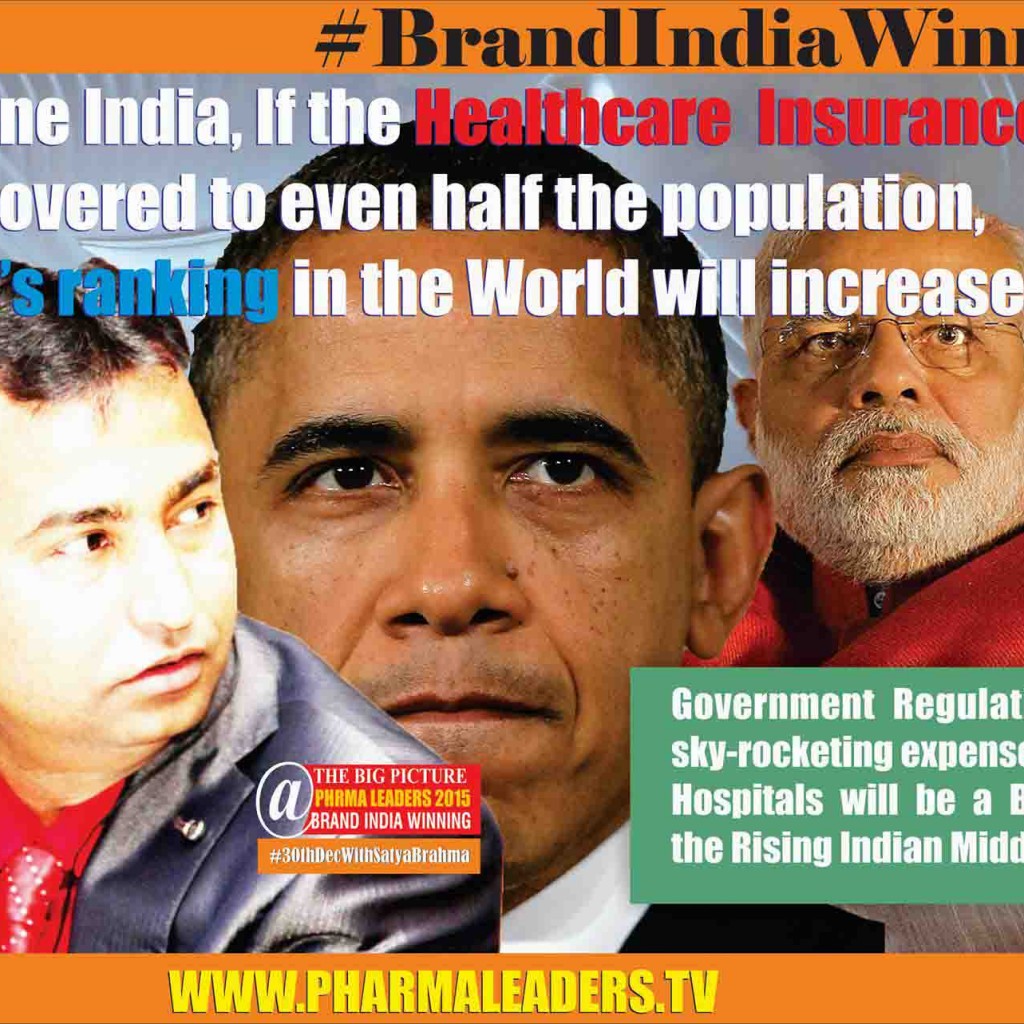Imagine India, If the Healthcare Insurance is covered to even half the population, India’s ranking in the World will increase!

Imagine India, If the Healthcare Insurance is covered to even half the population, India’s ranking in the World will increase!
Government Regulation to curb sky-rocketing expenses of Private Hospitals will be a Big Relief to the Rising Indian Middle Class!
India has double digit medical inflation. On the other hand, health cover is not adequate, and even employers’ health cover is insufficient in many cases, and individuals end up paying from their own pockets many a times. And, even though the premiums for health insurance have remained relatively stagnant, it has been mainly thanks to competition among the insurers. According to the report: Over the last four years, premiums of most insurers have increased only once – in 2014 – over the previous year, reflecting a CAGR of 2.79% (for sum insured of Rs 2,00,000 and Rs 3,00,000) and 3.29% (for sum insured Rs 5,00,000 and Rs 10,00,00).
95% of middle-class Indians do not have enough health insurance
Imagine India, If the Healthcare Insurance is covered to even half the population, Global image will increase! pic.twitter.com/aTNBeMDzMc
— SATYA BRAHMA (@SATYABRAHMA) December 23, 2015
The Big Picture
An increased appreciation of rapidly rising healthcare treatment costs does not seem to have translated into Indian consumers being better prepared. This is either because we, as consumers believe that we are a genetically healthy bunch or are unaware of just how expensive medical procedures have become. Around 95% of middle-class Indians do not have enough health insurance to cover some of the most common procedures and ailments in the country, according to a report by BigDecisions.com, one of India’s leading personal finance advice platforms. Surprisingly, consumers above 45 who are at higher risk of health problems and closer to retirement, are least prepared for emergencies as they are under-insured by an average of 69%.
An increased appreciation of rapidly rising healthcare treatment costs does not seem to have translated into Indian consumers being better prepared. This is either because we, as consumers believe that we are a genetically healthy bunch or are unaware of just how expensive medical procedures have become. It is getting more expensive to treat some of the most commonly occurring diseases in India. Amid an inflationary environment in India for at least a decade, prices four years ago were not exactly low. The fact that they have again risen, by double digits in some cities, is noteworthy.It is clear that there is room for Indian prices to increase further. We believe that current inflationary trends are likely to continue for the foreseeable future. While it is no surprise that typical treatment costs in the US are sometimes more than 10x what they are in India, that they are more than twice as expensive in countries closer to home such as Malaysia and Thailand, means Indians could soon be paying more.95% of our users are not adequately insured, with 62% of 10,000 BigDecisions users having less than 50% of required health cover. Consumers above 45 (with higher needs, typically higher incomes and fewer years to retirement) are a high-risk group – they are the least prepared for health emergencies as they are under-insured by an average of 69%.
We make the case not only for more resources but for a radically new architecture for India’s health-care system. India needs to adopt an integrated national health-care system built around a strong public primary care system with a clearly articulated supportive role for the private and indigenous sectors. This system must address acute as well as chronic health-care needs, offer choice of care that is rational, accessible, and of good quality, support cashless service at point of delivery, and ensure accountability through governance by a robust regulatory framework. In the process, several major challenges will need to be confronted, most notably the very low levels of public expenditure; the poor regulation, rapid commercialization of and corruption in health care; and the fragmentation of governance of health care. Most importantly, assuring universal health coverage will require the explicit acknowledgment, by government and civil society, of health care as a public good on par with education. Only a radical restructuring of the health-care system that promotes health equity and eliminates impoverishment due to out-of-pocket expenditures will assure health for all Indians by 2022.
translating this vision into action.
- India’s healthcare priority should be to dramatically improve preventive and primary care standards. Its facilities should be strengthened with more personnel, increased capacity building, and rigorous monitoring, all complemented with greater demand-side pressures. The primary health center (PHC) and its subcenters should be trained to act as a single-stop for all preventive and primary care services, and a gatekeeper for all referral services. While this is notionally their mandate even today, its compliance remains weak and these institutions have been reduced to being maternal and child health centers. All the existing national programs, including the village public health activities, should be closely integrated into the PHC and brought under the control of its medical officer. These facilities should be provided resources to equip themselves with all the basic infrastructure and equipments and maintain them in a clean and hospitable manner. Wherever the medical officer is not appointed, a senior staff nurse should be entrusted the supervisory responsibility.
- The PHC would act as a nodal agency co-ordinating all preventive and primary care activities – maternal and child health interventions, basic OP services, normal deliveries, administration of national programs, and coordination of village public health activities. This functional profile demands the services of a public health manager, more than a trained medical practitioner, much less one trained rigorously for more than five years. A three-year course with a curriculum designed to accordingly may be one way to also overcome the acute shortage of MBBS doctors that leaves a large proportion of PHCs without any doctor.
- Given that less than fully qualified (LTFQ) providers, commonly called quacks, are the point of first contact in nearly 80% of cases in rural areas, no meaningful reform is complete without integrating them into the mainstream. Their capacity building should involve continuous trainings and a gradually phased pathway to formality. One approach may be to offer a very basic preventive and primary care-focused course curriculum as a certificate in primary care, to be acquired over a 4-6 month duration of distance learning. The entire coursework can be provided on-line and through mobile phone apps, with the final examinations too conducted online under strict monitoring. Once they acquire the certification, these providers can be empanelled and used for various preventive and primary care services offered by the government in return for a fee.
- The secondary care institutions like the 30-100-bed community health centers (CHCs) should be strengthened with all basic facilities and kept very clean. Currently, they are the weakest part of India’s health care system. These hospitals should contain round-the-clock doctors and be equipped to handle basic surgeries including C-section deliveries. Wherever resources are extremely scarce, staff from two CHCs can be temporarily redeployed to run at least one full-fledged CHC. A mobile team of anesthetists can be made available if required.
- All tertiary care admissions, except in cases of emergencies, should happen only through the primary care center and preferably the first referral unit in the CHC. While this may be difficult to enforce, a variety of different approaches may have to be adopted to gradually internalize this approach among all the public and private stakeholders.
- It may be difficult to put the insurance genie back in the bottle. The next best option is to consolidate all the public insurance schemes offered to different categories of people under one umbrella, with a basic insurance plan and different types of top-ups, including those which provide premium care. Like in the continental Europe, the basic plan should be community-rated, cover a very basic set of high-incidence catastrophic medical conditions and no more, and have the same premium across insurers within a region. Private insurers should also offer this basic plan and at the same terms. They would be allowed to differentiate based on the top-ups and the quality of their services.
- The government, jointly with the private insurance agencies, should negotiate the annual price schedules of care providers and diagnostic services on a regional basis. This price schedule would be applicable for all government and private insurance and for any other contracting of services (like with CGHS). It would be a matter of debate as to whether the fee schedule should become the price standard for all categories of consumers as would be the case in a completely regulated market.
- The public tertiary care facilities should be strengthened with more facilities, greater cleanliness and responsiveness, and better management. Since such institutions are only a handful in each state, the state governments should take it up as a mission to bring them up to the standards of the best private hospital in the region. Patients under public insurance or being subsidized for their health care should be discouraged from visiting tertiary care facilities for simple secondary care treatments. Apart from providing affordable and accessible care for the poor, strong public tertiary care facilities are essential to keep private providers honest.
- In an environment where government hospitals are badly managed and discourage even those who cannot afford private hospitals, allowing insured citizens to choose their hospital is certain to further enfeeble public facilities. In the circumstances, there may be only two options. One, public insurance schemes can mandate that patients go to private facilities only in case the same treatment is not available at the public facility and on referral by the tertiary care facility (or on pre-authorization by the TPA). Two, the personnel delivering the care in the public facility should be incentivized with a share of the payments. It is not clear as to which of the two alternatives may work and a light-touch mix of both may be necessary.
- Finally, districts should be allowed to innovate to implement the components of this plan. The Government of India should offer a menu of interventions to improve health care service delivery – electronic medical records of all medical transactions in public facilities, strengthening of the rogi kalyan samitis at the PHC level, initiatives to make public facilities more attractive for patients, integration of the LTFQ care providers, rating of private providers and so on. The district may commit to the implementation of a clearly defined action plan consisting of some of these interventions and corresponding outcomes and enter into a 3-5 year MoU with the state National Health Mission Society. In return, the district should be encouraged with an incremental share of the NHM allocations. This strategy should not be forced upon all districts. In fact, only a handful of self-selected districts in each state should experiment with it, and based on their learnings, the strategy should be gradually expanded to cover others. Apart from closely monitoring and refining the programs, the state and central governments should encourage competition among those districts in the achievement of their action plans.
Now, it would be impossible to implement all these components in a one-size-fits-all mode across the country on a mission mode. It is just too complex. For sure, many of these reforms would struggle to pass the test of political acceptability and seriously strain the administrative bandwidth for effective implementation. Greater program flexibility would certainly lead to failures and scams. Dfferent parts of the country, even parts of the state, will progress at different pace in implementation. But given the enormity of the challenge, this may be the only way to initiate a process which could, potentially, over a long time frame, atleast stand a reasonable chance of getting us to the destination.
Not long ago, consumers could access health information about as easily as they could access plutonium. This is changing rapidly in the information age. As a result, consumers—rather than doctors, government, insurers, hospitals, or healthcare companies—will own the Healthcare Century. Any healthcare institution that ignores this trend does so at its peril.Before the information age, consumers were almost entirely beholden to their physicians for information about health and disease. Now, consumers increasingly educate themselves using the Internet to learn about their health, illnesses, and symptoms. Every day, the patient-doctor relationship becomes more of a partnership as patients come up the learning curve.Previously, the system kept you from your test results until a doctor had time to interpret it for you. Now, mobile health innovations not only allow consumers and caregivers to obtain more data about the body, they also making such data obtainable under consumer control rather than under the control of the healthcare system. Such real-time, self-gathered health data may help the informed healthcare consumer keep doctors away.Until recently, patients were asked to participate in clinical trials about which they knew very little. They underwent therapies that they could not independently research. Informed consent was not very truly informed, and patients were expected to trust the system—a concession of power to experts who might harbor biases or misaligned incentives. In the social media age, consumers are taking back some of that power by tapping into online communities and FDA clinical trial sites to gather additional information.Pricing and performance opacity has long been the norm in healthcare. Stories about the variation in what hospitals charge different patients for the same treatment were once merely anecdotal. Consumers now share their medical bills online, and healthcare pricing data is being aggregated to create transparency for consumers. Similarly, consumers share their performance reviews of doctors and hospitals.Consumers are not only empowering themselves through information about health but also by becoming participants in health innovation. Patient groups such as the Cystic Fibrosis Foundation and Food Allergy Research & Education directly fund and develop novel therapies that benefit patients in partnership with industry. The 2010 Patient Protection and Affordable Care Act established The Patient-Centered Outcomes Research Institute, which enables patients to become directly involved in improving healthcare research and outcomes.Information is power, and a tectonic power shift is catalyzing a revolution in healthcare as information becomes demystified and liberated to consumers. The Gutenberg press liberated the printed word and the human mind, spawning an unprecedented era of human progress. As consumers take control of the future of healthcare, an unprecedented era of medical progress will soon be upon us.
How can you Ensure Healthcare Reforms When Statistics say the real pictures. How to Fix Accountability of Doctors is also a major challenge.
- There is just one doctor per 2000 people in India
- There is acute shortage of 64 lakh skilled human resource in the sector
- The physician density of India per 10,000 populations stands poorly at 6.5 against a global average of 14.2.
- The density of hospital beds per 10,000 populations, which stands at nine against a global average of 30. doctors don’t want to serve rural India. They are very averse about their posting in countryside areas. maximum doctors in urban India are without the MBBS disagrees.
- Healthcare Insurance almost non-existent. Unlike in the US, ordinary patients in India have no meaningful insurance to cover healthcare expenses. Most have to pay the medical bill on their own, and an increase in defensive medicine may affect these patients economically. But it is also true that in the absence of any insurance oversight, and without any government regulation, hospital expenses are skyrocketing in India
- There are just 0.64 doctors and 1.44 nurses for 1,000 Indians. The ratio halves for rural India with a large number of health personnel working in urban areas. Although the number of health personnel has increased the demand for medical treatment has also risen with improvement income in recent years
- A comprehensive study found that defensive medicine may contribute only 1-2% of the cost of US healthcare.
- Malpractice liability may have a moderate degree of deterrent effect in countries with an effective regulatory system through medical council or board that routinely uses disciplinary action to curb negligence and unethical behaviour by doctors. Unfortunately, medical councils in India have been riddled with incompetence and deep rooted corruption. Disciplinary action against negligent or unethical doctors by medical councils, which comprise only doctors, is almost non-existent in India










